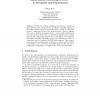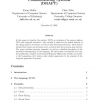1003 search results - page 110 / 201 » How to Parallelize Sequential Processes |
SAC
2009
ACM
14 years 3 months ago
2009
ACM
Parallel architectures are the way of the future, but are notoriously difficult to program. In addition to the low-level constructs they often present (e.g., locks, DMA, and non-...
IPPS
2007
IEEE
14 years 3 months ago
2007
IEEE
The processing power and memory capacity of independent and heterogeneous parallel machines can be combined to form a single parallel system that is more powerful than any of its ...
IPPS
1999
IEEE
14 years 1 months ago
1999
IEEE
Predictable network computing still involves a number of open questions. One such question is providing a controlled amount of CPU time to distributed processes. Mechanisms to cont...
CONCUR
1990
Springer
14 years 29 days ago
1990
Springer
In this paper we describe the calculus TCCS, an extension of the process algebra CCS with temporal constructs. The calculus is useful for the formal analysis of the timing aspects...
EDO
2000
Springer
14 years 16 days ago
2000
Springer
Abstract. We demonstratehow the use of synchronizationprimitives and threading policies in distributed object middleware can lead to deadlocks. We identify that objectmiddleware on...


